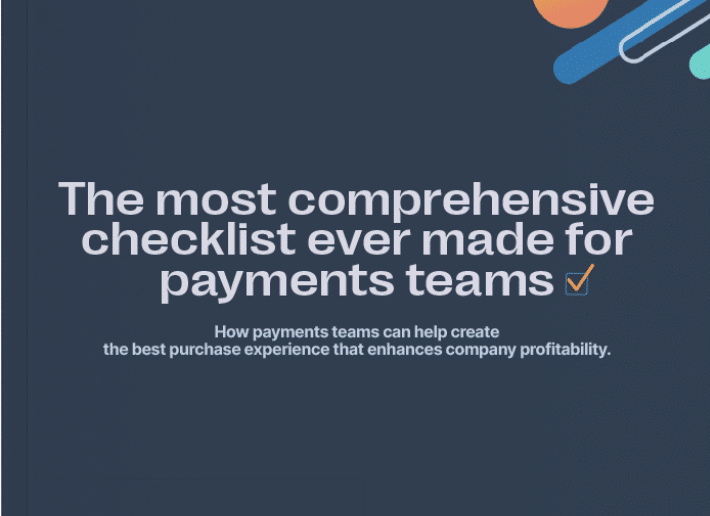The most comprehensive checklist ever made for payments teams
How payments teams can help create the best purchase experience that enhances company profitability. We wanted to put together the most holistic & comprehensive checklist to help merchants better understand and solve the issues that chargebacks present.
1. Seamless & Secure Checkout Process
Simplify the checkout process:
Make sure the checkout process is easy, intuitive, and has as few steps as possible to reduce shopping cart abandonment. By bringing up this conversation with other departments, Payments teams can offer usable data to help justify an initiative around this.
Show clear pricing:
Ensure all prices, taxes, and shipping costs are clear and visible before the customer finalizes the purchase. One of the best industries at this is airlines, as DOT (U.S. Department of Transportation) requires them to be 100% transparent with their pricing at all times.
Offer various payment options:
Cater to all customers by providing multiple payment options (credit/debit cards, mobile wallets, direct bank transfers, etc.). One clear reason for this is the need to accommodate consumer habits in order to maximize your chances at winning the sale while reducing as much friction in the process, giving the customer what they want.
Implement strong security measure:
Use SSL encryption, 3D Secure, and other security protocols to build customer confidence in your organization. Consumer hesitancy is at an all-time high, so the more ways you can show the legitimacy of your business, the more likely the consumer will be to complete the transaction.
Real-time order confirmation:
Send immediate order confirmation via email or text to reassure customers their transaction was successful. Plus, this is a great opportunity to partner with your marketing department to have fun with these communications while building the brand to encourage repeat buyers.
2. Effective Fraud Prevention
Use a robust fraud detection system:
Implement a system that uses machine learning to identify and flag potential fraudulent transactions.
Apply address verification service (AVS):
This checks the entered billing address against the one the card issuer has on file and can be great evidence to have documented should any fraud occur.
Card verification value (CVV) check:
Require CVV for all transactions to ensure physical possession of the card. Although some teams may say zip code is enough for a quicker checkout, this is another great safeguard to have in place.
3. Transparent and Consistent Communication
Clear product descriptions:
Provide accurate and detailed descriptions and images of your products to set appropriate customer expectations. “What you see is what you get” should be the phrase that reigns true across all merchants. After all, you should be proud of the products you’re selling and showcase them with confidence.
Order status updates:
Regularly communicate the status of the order (processing, shipped, delivered) to keep customers informed. These communications present significant opportunities to keep the customer engaged, but also begin planting the seeds to come back and buy more products. This is such a great conversation to strike up with your marketing team, as they are laser focused on all touchpoints that relate back to revenue or customer satisfaction.
Transparent return and refund policies:
Make these policies readily accessible and easy to understand to avoid misunderstandings. Let’s be honest, if this is difficult for the customer to understand, irrational behavior and decisions may follow suit purely out of spite. These should be opportunities to enhance the brand and, though difficult to have, senior leadership should be looped into the conversation around the negative implications of a convoluted policy.
Proactive customer service:
Set up a responsive customer service team that can quickly address customer concerns, ideally before they escalate to chargebacks. This is such an integral part of operational success, that we want to unpack this completely in the next list!
4. Partner with Customer Service and Experience Teams
First Line of Contact:
Customer service representatives are often the first line of contact for customers when they have a problem. If they can solve the issue promptly and efficiently, customers are less likely to initiate a chargeback. More importantly, however, this moment of truth with an unhappy customer presents a significant opportunity to build loyalty and encourage positive word of mouth.
Building Relationships:
At the end of the day, EVERYONE in the organization should care about the relationship with each and every customer. Customer service teams are often tasked with maximizing the relationship with each customer, though they’re often faced with difficult conversations where the customer is unhappy. The more payments teams can equip customer service teams with data and support, the more likely these efforts will result in more positive relationships.
Preventing Chargebacks:
In some cases, customers might initiate a cahargeback out of frustration or misunderstanding. A well-trained customer service representative can identify these situations and provide suitable solutions before a chargeback is initiated. How many times have you experienced a situation where a chargeback occurred that could have easily been handled by a positive experience with customer service? We know…but it’s up to YOU to lead that conversation!
Detecting Patterns:
Customer service teams can help detect patterns in customer complaints that might indicate a larger issue with a product or process. These insights can then be used to rectify the root cause and prevent future chargebacks. Additionally, this data can help the organization make stronger business decisions that approach the full spectrum of the issue.
5. Involvement of Other Departments
Product Development:
If a product isn’t meeting customer expectations, it may result in a higher number of chargebacks. Collaborating with the product team to continuously improve products based on customer feedback is a key strategy for reducing dissatisfaction and chargebacks. Why would you not bring this valuable intel to the team if you know it will help the business grow?
Finance:
Finance teams should be looped in to understand the financial impact of chargebacks and to help forecast future losses. They can also help track the cost of disputes, aid in budgeting for fraud prevention tools, and analyze the ROI of these investments. Oftentimes, these departments may not be looking at the ledger in the most effective way to transparently show the ins and outs of each chargeback, leading to faulty data and, even worse, poor business decisions.
Legal:
Legal teams can help ensure compliance with all regulatory standards related to payment processing and consumer rights, reducing the risk of penalties or regulatory chargebacks. This team can also help with the policy management to ensure you’re within the required guidelines while still developing clearer policies that result in less chargebacks.
HR & Training:
Training programs for staff members on fraud detection and prevention, customer service excellence, and handling disputes can be beneficial. The HR team can help in designing and implementing these training sessions, helping develop a strong culture while ensuring compliance. HR teams tend to have phenomenal methods for coaching employees and are usually the first to help out when other departments reach out.
6. Compliance and Regulations
Stay up to date with card network rules:
Regularly review and comply with rules set by credit card networks like Visa, MasterCard, etc. Here’s a great resource for Visa Compelling Evidence 3.0 and another on PSD2.
Adhere to regional & national regulations:
Comply with regional laws and regulations related to payments and consumer privacy, such as PSD2 and GDPR in Europe.
7. Analyze and Learn from Past Chargebacks
Identify common reasons for chargebacks:
Analyzing previous chargebacks can help realize patterns & areas that need improvement. Going back & studying the data of your chargebacks can be a huge indicator of broader business issues that need to be addressed. Without a strong solution in place for chargeback management, this task is hauntingly manual but has a significant upside if you can apply the learnings to make handling future chargebacks more efficient and successful.
Implement necessary changes:
Once issues are identified, make the necessary changes to policies, procedures, or systems to prevent future chargebacks. Tap into external software that can handle this research and analysis at the scale you need, allowing you to focus more on the business. If the changes you’ve implemented aren’t moving the needle enough, it may be time to look into something more powerful that can handle the volume required for retaining the revenue you rightfully earned.








